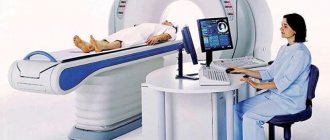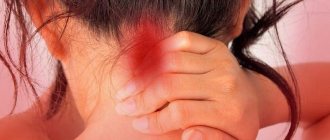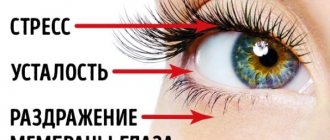Headache and soreness in the right eye area may indicate serious health problems.
Receptors responsible for pain are located in the veins, blood vessels and lining of the brain.
We recommend reading: Headache and blurred vision
This can make it feel like only half of your face and head are hurting. Pain on the right side often occurs due to mechanical injury and migraines. It is extremely rare that the right hemisphere of the head and eyes may hurt due to the presence of a malignant tumor on the right side. In any case, if you experience pain and discomfort, you must visit a specialist to make an accurate diagnosis and eliminate the problem.
Causes
Pain in the area of the right eye and head can occur for many reasons, but there are several main ones, the manifestation of which cannot be self-medicated. Causes of prolonged headaches and discomfort:
- Prolonged fatigue and being under severe stress. Soreness may be accompanied by throbbing and discomfort in the area of the right eye. It often occurs when spending a long time at the computer or in front of the TV. In this case, pain on the right side can occur in the morning or evening and manifest itself as a stabbing sensation in the temple or forehead area.
- Bruises of various types. The slightest blow can lead to concussions, which ultimately lead to brain diseases.
- Glaucoma and other eye diseases. If one eye is affected, the patient experiences severe discomfort. The pathology may be accompanied by a prickly sensation in the eyes, and the image begins to float.
- Incorrect selection of contact optics (lenses or glasses). When wearing incorrectly selected optical accessories, discomfort may occur in one or both eyes, migraines may develop, lacrimation increases, and the eyes quickly become tired.
- Spasmodic attacks in blood vessels. If the load is not performed correctly, compression or damage to blood vessels occurs in the cervical spine. As a result of such a clamp, pain may occur in the right side of the head, minor hemorrhages causing discomfort. A migraine may develop, with pain radiating to the right eye. Additionally, nausea, absent-mindedness, and slight loss may appear.
- Osteochondrosis – can cause headaches, dizziness and pain in the neck and eyes. Symptoms can appear with varying intensity, both on the right side and on the left.
- Hematoma inside the skull, malignant formations, meningitis and a pre-stroke condition - all this can provoke pain in the head and eye area on the right side. Additionally, with these conditions, the patient may experience significant weight loss, morning sickness, and frequent cramps.
- Eye injuries and infectious diseases can also cause pain on the right side.
- Colds and diseases of the respiratory system.
- Damage to the vascular system.
Additional symptoms
Concomitant symptoms help to more accurately identify the cause of the headache on the right side. They also need to be reported to the doctor when contacting for a primary diagnosis. Treatment of headaches should also be carried out by a specialist, because cephalalgia is often a symptom of serious illnesses.
Migraine
At risk are, first of all, representatives of the fair sex aged 20 to 40 years. If a woman has a headache that throbs and gradually gets worse, a migraine attack can be suspected.
Associated signs of this pathology are decreased visual acuity, photophobia, intolerance to loud sounds, nausea (sometimes vomiting). As a rule, a few hours before the attack, weakness and depression appear.
Cluster syndrome
Unlike migraine, this disease occurs predominantly in men, most often in smokers or alcohol abusers. The pain occurs suddenly and can affect both the left and right sides, the top or frontal part of the head. The pain impulse radiates to the eye or temple, accompanied by lacrimation, nasal congestion, increased blood pressure, and hemorrhage in the eye.
Costen's syndrome
This is the name for damage to the nervous and bone tissue of the temporomandibular joint. The pain affects the right side of the head, face, temporal region, and less commonly, the neck.
Additional signs of this disease are limited movement of the lower jaw, hypersalivation, herpetic rashes in the mouth, on the ears, and dizziness.
Intracranial bleeding
A hemorrhagic stroke, ruptured aneurysm, or severe skull injury is accompanied by hemorrhage. In addition to sudden intense pain, the following are observed:
- increased blood pressure;
- nausea, vomiting;
- disorders of coordination, speech, thinking;
- disturbance of consciousness;
- drowsiness;
- fainting.
Cephalgia against the background of the listed symptoms requires immediate transportation of the sick person to a medical facility.
Concussion
A closed head injury is accompanied by pain of varying degrees of intensity, weakness, dizziness, and tinnitus. If a person faints, a TBI can be suspected by the presence of bruises or abrasions on the head. The conscious patient usually feels very nauseous and vomits frequently.
Tumor
Neoplasms, benign and malignant, are always clearly localized, which is why the right side of the head or the left hurts. A distinctive feature of cephalgia in brain tumors is its constant, incessant nature.
As the formation grows, the pain intensifies and cannot be relieved even with potent analgesics. The patient usually does not feel like eating, he is irritable, and often experiences attacks of nausea, impaired consciousness, and dizziness. Convulsions, epileptic seizures, and fainting may also occur.
What to do if a symptom occurs
To alleviate pain before visiting a specialist, the first step is to restore normal sleep and give the body a rest. To do this, you can take an infusion of valerian. You should avoid drinking strong coffee drinks that contain caffeine. Instead, it is better to brew tea with the addition of thyme, mint and chamomile. You can reduce pain by applying cold to the place where it appears; for this it is better to make a compress using ice.
During the period of migraine and severe pain on the right side of the head, discomfort can be reduced with the help of special massage actions. To do this, you should very carefully massage the area where the pain is coming from with your fingers. The duration of such a massage should be at least 10 minutes. It must be remembered that in cases where the pain is caused by tumors, massage is prohibited.
You also need to know that folk remedies can help relieve discomfort only with mild symptoms. In the event of cerebral hemorrhages, vomiting, or dizziness, self-medication is prohibited. In such cases, effective treatment should only be determined by a specialist, since such manifestations cannot always be cured with medication.
It is important to understand that the first step is to determine the reason why the pain appeared on the right side. It is necessary to undergo an examination consisting of the following procedures:
- a deep blood test that allows you to see all possible deviations from the norm;
- computed tomography - to identify possible tumors and problems with blood vessels that cause pain;
- ophthalmological examination – necessary to exclude problems with the visual organs.
Further prescription of therapeutic therapy will directly depend on the cause of pain. During the examination, in case of short-term pain, specialists allow you to take painkillers. Often the patient is recommended to take Analgin, Spasmalgon or Citramon, as they relieve spasms, help dilate blood vessels and stop pain.
If you have a severe migraine on the right side of your head, you should take an anti-inflammatory drug that will help eliminate fatigue and relieve pain. It is important to increase the amount of water you drink and get more rest, preferably in the fresh air.
What to do if you have a headache on the right side
Diagnosis and treatment of headaches under the supervision of a doctor are necessary if:
- the symptom will persist for several hours and does not respond to analgesics and antispasmodics;
- sensations are pronounced and increase quickly;
- pain in the head appeared after a skull injury;
- the patient is disoriented, he has a nosebleed, he loses consciousness;
- an alarming sign occurs more than 3 times a week;
- The patient's vision has deteriorated, his gait has become disturbed, tremors in his fingers or facial asymmetry have appeared.
If at least one of the points is present, it is better not to risk your health, but to call a doctor or an ambulance at home. Before visiting a specialist, it is recommended to stop taking medications and use physiotherapeutic methods, so as not to aggravate the condition or smooth out the clinical picture.
Diagnostics
Even in the presence of a clear clinical picture, a preliminary diagnosis needs to be confirmed. To determine the cause of pain in the area of the right side of the head, general and biochemical blood and urine tests are used. They allow you to identify an inflammatory or infectious process and suspect the presence of a tumor. If meningitis is suspected, the patient undergoes a lumbar puncture. In some cases, CT, MRI, ultrasound of the brain and neck vessels, and radiography are required.
Treatment
It is better to postpone taking medications for headaches until you visit a doctor. As a last resort, you can take a Citramon or Ibuprofen tablet. The absence of a reaction to the medicine within half an hour does not mean that the manipulation needs to be repeated or the dosage of the drug must be increased. Such actions may increase symptoms or provoke adverse reactions.
Here are a few acceptable manipulations that can relieve right-sided headaches:
- rest in a dark and cool place;
- application of relaxation methods;
- eliminating external stimuli in the form of loud sounds, strong odors or bright lights;
- compress on the forehead and temples or the back of the head - the cloth can be moistened with warm or cool liquid, cabbage juice, a solution of apple cider vinegar and water (the components are taken in equal proportions);
- drinking tea with mint, chamomile or lemon balm.
An effective and safe method of combating cephalalgia is massage. This may be a general effect on the head or collar area, stimulating biologically active points. To enhance the result, manipulation can be carried out using vegetable oil, to which a couple of drops of mint essential oil have been added.
Complications
Most often, the right side of the head and the right eye hurt due to migraine. This disorder causes pain in the right temporal lobe; with strong tension in the temporal artery, the pain spreads to the eye. In rare cases, the pain spreads to the heart area, which can provoke frequent urination.
Migraines can cause discomfort, which is accompanied by nausea and vomiting. Dizziness, severe drowsiness and increased fatigue may occur.
You need to understand that a distinctive feature of migraine is its manifestation in the morning. Along with the pain, severe irritability and nervousness may occur. Moreover, such manifestations quickly disappear after taking painkillers.
Why does the right side of my head hurt and radiate to the eye?
Migraine manifests itself as severe pain from one hour to several days and is accompanied by dizziness, pain in the eyes, visual disturbances in the form of black spots, flashes of light, and blurriness.
There are 2 subtypes of migraine: without aura and with aura. The second type is distinguished by the appearance of specific symptoms before the onset of an attack.
Occipital neuralgia is a lesion of the lesser and greater occipital nerves in the cervical region on the right. Occurs as a result of injuries, infection, tumors, hemorrhages, diabetes mellitus, systemic diseases, degenerative changes in the bones and spine. A static posture with the head down can provoke the disease.
Inflammation of the oblique eye muscle. Dull or severe pain appears in the inner corner of the eye and above it. The cause is considered to be autoimmune and rheumatoid diseases, conditions with a history of inflammation in connective tissues. In persons predisposed to migraine, an exacerbation of the attack is possible.
Pathologies of the paranasal sinuses are an inflammatory process accompanied by swelling. Appears when exposed to allergenic irritants, bacteria and viruses, fungal infections. When the sinus is blocked, the head, eye, neck hurts, chills, cough, and general weakness appear.
Referred pain – transmitted from the affected organ to the eye and right side of the head. It happens with brain damage, cervical pathologies, cervicalgia.
Cluster headaches are intense, unilateral attacks that can last up to 12 weeks without treatment. They radiate to the temple, neck, shoulders, any part of the head, eyes. They appear suddenly and may occur sporadically several times a day for up to 3 hours. The eye may turn red, watery eyes and swelling of the eyelid may appear.
Prevention
Most diseases cause pain, which is almost impossible to prevent. In this regard, there are no precise preventive measures. To prevent the development of unpleasant sensations, you should protect the body from overexertion. Mental and physical fatigue can negatively affect people's health.
To prevent severe headaches, you should spend more time outdoors. Also, regular exposure to the street will contribute to the overall strengthening of the body.
Attention should be paid to a healthy lifestyle, especially for people who have sedentary jobs. Adequate sleep is also important, the duration of which should be at least 8 hours a day. This time is enough for the body to regain strength and rest. To ease pain, you can, if possible, replace trips on public transport with walking.
It must be remembered that the more the patient protects himself from stress and various strains, the less pain will appear in the right side of the head and eyes.







